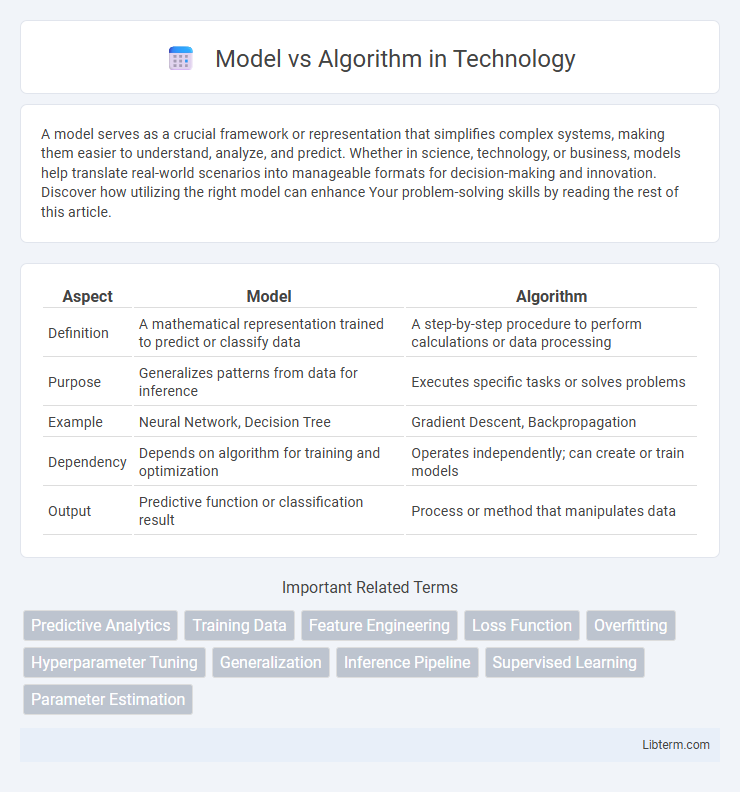A model serves as a crucial framework or representation that simplifies complex systems, making them easier to understand, analyze, and predict. Whether in science, technology, or business, models help translate real-world scenarios into manageable formats for decision-making and innovation. Discover how utilizing the right model can enhance Your problem-solving skills by reading the rest of this article.
Table of Comparison
| Aspect | Model | Algorithm |
|---|---|---|
| Definition | A mathematical representation trained to predict or classify data | A step-by-step procedure to perform calculations or data processing |
| Purpose | Generalizes patterns from data for inference | Executes specific tasks or solves problems |
| Example | Neural Network, Decision Tree | Gradient Descent, Backpropagation |
| Dependency | Depends on algorithm for training and optimization | Operates independently; can create or train models |
| Output | Predictive function or classification result | Process or method that manipulates data |
Understanding the Basics: What is a Model?
A model is a mathematical representation or abstraction constructed from data to make predictions or decisions, often derived through training algorithms in machine learning. It captures patterns and relationships within the data, enabling it to generalize and infer outcomes for new, unseen inputs. Unlike algorithms, which are step-by-step procedures or rules for processing data, models embody the learned knowledge used for evaluation and forecasting tasks.
Defining an Algorithm: The Step-by-Step Process
An algorithm is a precise, step-by-step procedure designed to perform a specific task or solve a problem systematically. It consists of a finite sequence of well-defined instructions that guide the computer through input processing, computation, and output generation. Algorithms form the foundation for building models by providing the logical framework to train, optimize, and evaluate them effectively.
Core Differences Between Models and Algorithms
Models represent the learned patterns or structures derived from data, enabling predictions or decisions, while algorithms are the step-by-step procedures or instructions used to train models or process data. Algorithms define the method of computation, such as gradient descent or decision trees, whereas models are the output, like neural networks or regression equations, that encapsulate the knowledge extracted. The core difference lies in algorithms being the process, and models being the product of applying that process to data.
How Models and Algorithms Work Together
Models represent patterns learned from data, while algorithms are the step-by-step procedures used to train these models by optimizing parameters. Machine learning algorithms process input data to adjust model weights, minimizing errors and improving predictions. This synergy enables models to generalize from training data and apply learned knowledge to new, unseen information.
Real-World Examples: Models in Action
Models like Google's AlphaGo demonstrate how machine learning algorithms create representations of complex gameplay to predict moves and outcomes. Fraud detection systems in finance use classification models trained on transaction data to identify suspicious activities in real time. Autonomous vehicles rely on computer vision models to interpret sensor inputs and make driving decisions based on dynamic environmental conditions.
Practical Applications: Algorithms at Work
Algorithms form the backbone of practical applications by providing step-by-step instructions to solve problems or perform tasks, enabling software to process data efficiently. In machine learning, algorithms drive the training process by iteratively adjusting parameters to fit data, ultimately producing models that can make predictions or classifications in real-world scenarios such as fraud detection, recommendation systems, and autonomous vehicles. The effectiveness of algorithms in tasks like sorting, searching, optimization, and pattern recognition directly impacts the accuracy and performance of the resulting models deployed across various industries.
Why the Distinction Matters in Machine Learning
The distinction between a model and an algorithm is crucial in machine learning because the algorithm serves as the procedure or set of rules used to train or optimize the model, while the model is the output, representing the learned patterns from data. Understanding this difference influences how practitioners approach tasks such as tuning, evaluation, and deployment, ensuring the right focus on model accuracy versus algorithm efficiency. Recognizing their unique roles enhances the development of robust systems capable of generalizing well to unseen data.
Common Misconceptions About Models vs Algorithms
Models and algorithms are often confused, but they serve distinct roles in machine learning; an algorithm is a set of rules or instructions for processing data, while a model is the output generated by applying an algorithm to training data. A common misconception is that models and algorithms are interchangeable, yet algorithms create models that predict or make decisions based on new inputs. Understanding this distinction is crucial for accurately evaluating machine learning processes and outcomes.
Choosing the Right Approach: Model or Algorithm?
Choosing the right approach between a model and an algorithm depends on the specific problem and data requirements; a model represents learned patterns from training data, while an algorithm is a step-by-step procedure to perform a task or solve a problem. For predictive analytics, models such as neural networks or decision trees are essential because they can generalize from historical data, whereas algorithms like sorting or searching are fundamental for data processing and optimization tasks. Evaluating the problem context, goal, and available data ensures selecting the most effective combination of models and algorithms to deliver accurate and efficient outcomes.
Future Trends: Evolving Roles in AI and Data Science
Future trends in AI and data science highlight the evolving roles of models and algorithms, with models becoming increasingly complex through techniques like deep learning that enable adaptive, data-driven decision-making. Algorithms continue to advance by incorporating automated machine learning (AutoML) frameworks, optimizing model selection and hyperparameter tuning to improve efficiency. The integration of explainable AI (XAI) further enhances transparency, allowing algorithms and models to be more interpretable, thereby fostering trust in AI systems across industries.
Model Infographic

 libterm.com
libterm.com